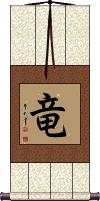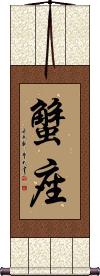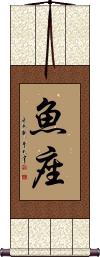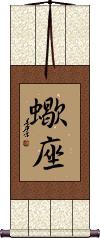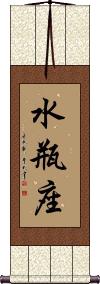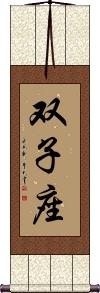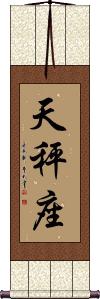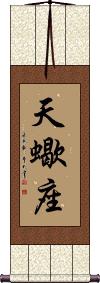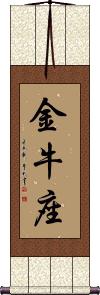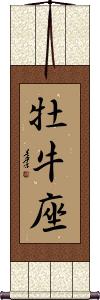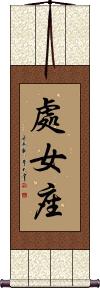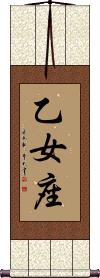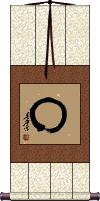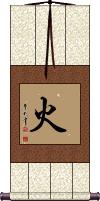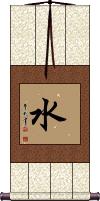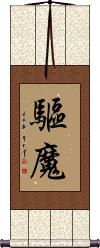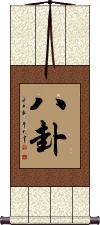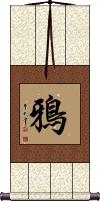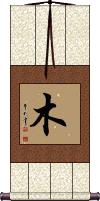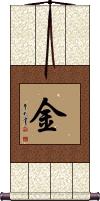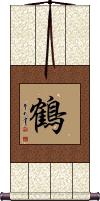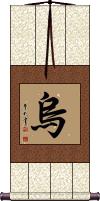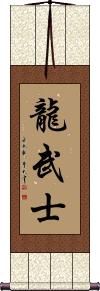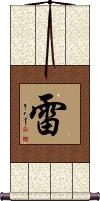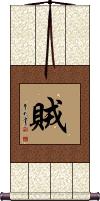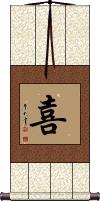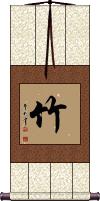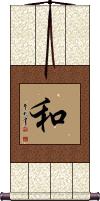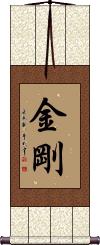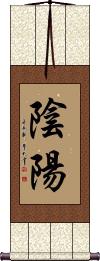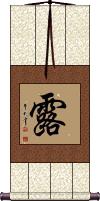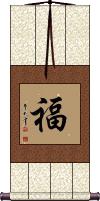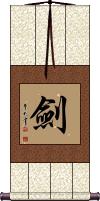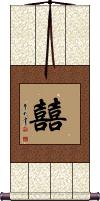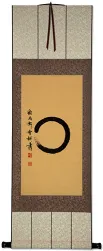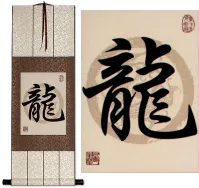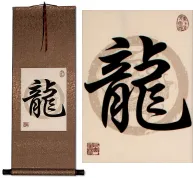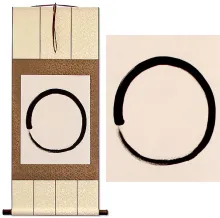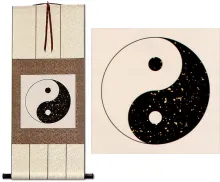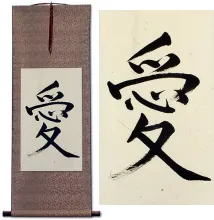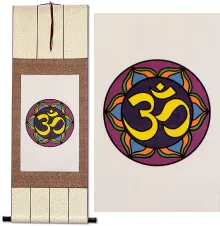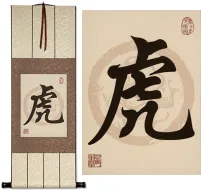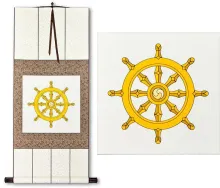Many custom options...
And formats...

Symbol in Chinese / Japanese...
Buy a Symbol calligraphy wall scroll here!
Personalize your custom “Symbol” project by clicking the button next to your favorite “Symbol” title below...
3. Cancer
4. Pisces
5. Scorpio
6. Aquarius
7. Aries
8. Cancer
9. Capricorn
10. Gemini
11. Leo
12. Libra
13. Ophiuchus
14. Pisces
15. Sagittarius
16. Scorpio
17. Taurus
18. Virgo
19. Enso - Japanese Zen Circle
20. Fire
21. Water
22. Repel Evil / Expel the Devil
23. Ba Gua
24. Wisdom Lotus
25. Raven / Crow
26. Wood
27. Gold / Metal
28. Crane
29. Black Raven
30. Dragon Warrior
31. Thunder
35. Bamboo
36. Peace / Harmony
38. Yin Yang
39. Dew
40. Diamond
42. Sword
43. Double Happiness
Reiki - Master Symbol
大光明 is the master symbol “Daikomyo” or “Dai Ko Myo,” which is usually associated with the healing practice of Reiki.
This title can be translated as “Great Bright Light.” This symbol, as used in Reiki, alludes to “Enlightened Nature” or the radiance of a purified soul or deity.
Pronunciations in Chinese and Korean are included above but this title has no meaning except when used by a Reiki practitioner. In fact, this title is not that well known by those outside the Reiki community in Japan.
In Chinese, this would be interpreted as “Great Bright Future” (the second two characters alone create a word that means “bright future” in Chinese).
Dragon / Emperor Symbol
竜 is an alternate form of the dragon.
Still pronounced the same in Chinese, Japanese, and Korean.
This particular Kanji is often associated as an imperial symbol as well as representing the mythical Asian dragon. You may have seen it on the chest or flag of the emperor in old Japanese and Chinese movies.
Note: I would rate this as a non-universal alternate form. The other dragon character is by far more common, and universally understood.
We strongly recommend ![]() if you are looking for the symbol of dragon.
if you are looking for the symbol of dragon.
Cancer Zodiac Symbol / Sign
蟹座 is the Japanese way to write Cancer (crab) of western astrology.
Please note this version is only used in Japanese (see the other version if Chinese is your audience).
See Also: Chinese Zodiac
Pisces Zodiac Symbol / Sign
魚座 is the Japanese way to write Pisces (fish) of western astrology.
Please note this version is only used in Japanese (see the other version if Chinese is your audience).
See Also: Chinese Zodiac
Scorpio Zodiac Symbol / Sign
蠍座 is the Japanese way to write Scorpio (scorpion) of western astrology.
Please note this version is only used in Japanese (see the other version if Chinese is your audience).
See Also: Chinese Zodiac
Aquarius Zodiac Symbol / Sign
水瓶座 is the Chinese and Japanese way to write Aquarius (water bearer) of western astrology.
See Also: Chinese Zodiac
Aries Zodiac Symbol / Sign
牡羊座 is the Chinese and Japanese way to write Aries (ram) of western astrology.
See Also: Chinese Zodiac
Aries Zodiac Symbol / Sign
(Alternate / Chinese)
白羊座 is an alternate Chinese way to write Aries (ram) from western astrology.
I don't believe it is used at all in Japanese, so the other version is probably better or at least more universal.
See Also: Chinese Zodiac
Cancer Zodiac Symbol / Sign
巨蟹座 is the Chinese way to write Cancer (crab) from western astrology.
Please note this version is only used in Chinese (see the other version if Japanese is your audience).
See Also: Chinese Zodiac
Capricorn Zodiac Symbol / Sign
山羊座 is the Chinese and Japanese way to write Capricorn (horned goat) from western astrology.
See Also: Chinese Zodiac
Capricorn Zodiac Symbol / Sign
(Alternate / Chinese)
摩羯座 is an alternate Chinese way to write Capricorn (horned goat) from western astrology.
I don't believe it is used at all in Japanese, so the other version is probably better or at least more universal.
See Also: Chinese Zodiac
Gemini Zodiac Symbol / Sign
雙子座 is the Chinese way to write Gemini (twins) of western astrology.
This was also the version used in Japan until they simplified the first Kanji to 双 after WWII. If you need the modern Japanese 双子座 instead of the older 雙子座, just let me know when you place your order.
See Also: Chinese Zodiac
Gemini Zodiac Symbol / Sign
雙子座 is the Japanese way to write Gemini (twins) from western astrology.
This also happens to be the Simplified Chinese version of this title - however, I recommend the Traditional Chinese version if your audience is Chinese.
See Also: Chinese Zodiac
Leo Zodiac Symbol / Sign
獅子座 is the Chinese and Japanese way to write Leo (lion) of western astrology.
See Also: Chinese Zodiac
Libra Zodiac Symbol / Sign
天秤座 is the Chinese and Japanese way to write Libra (scales) of western astrology.
See Also: Chinese Zodiac
Ophiuchus Zodiac Symbol / Sign
蛇夫座 is the Chinese way to write Ophiuchus (the serpent bearer) of western astrology.
Please note this version is only used in Chinese (not Japanese).
See Also: Chinese Zodiac
Pisces Zodiac Symbol / Sign
雙魚座 is the Chinese way to write Pisces (fish) from western astrology.
Please note this version is only used in Chinese (see the other version if Japanese is your audience).
See Also: Chinese Zodiac
Sagittarius Zodiac Symbol / Sign
射手座 is the Chinese and Japanese way to write Sagittarius (archer) of western astrology.
See Also: Chinese Zodiac
Scorpio Zodiac Symbol / Sign
天蠍座 is the Chinese way to write Scorpio (scorpion) from western astrology.
Please note this version is only used in Chinese (see the other version if Japanese is your audience).
See Also: Chinese Zodiac
Taurus Zodiac Symbol / Sign
金牛座 is the Chinese way to write Taurus (bull) from western astrology.
Please note this version is only used in Chinese (see the other version if Japanese is your audience).
See Also: Chinese Zodiac
Taurus Zodiac Symbol / Sign
牡牛座 is the Japanese way to write Taurus (bull) from western astrology.
Please note this version is only used in Japanese (see the other version if Chinese is your audience).
See Also: Chinese Zodiac
Virgo Zodiac Symbol / Sign
處女座 is the Chinese way to write Virgo (virgin) from western astrology.
Please note this version is only used in Chinese (see the other version if Japanese is your audience).
See Also: Chinese Zodiac
Virgo Zodiac Symbol / Sign
乙女座 is the Japanese way to write Virgo (virgin) from western astrology.
Please note this version is only used in Japanese (see the other version if Chinese is your audience).
See Also: Chinese Zodiac
Enso - Japanese Zen Circle
〇 is the famous Enso symbol, which you will see widely used by Japanese Zen Buddhists.
In a twist, I am starting to see Enso used more and more by Chinese Buddhists.
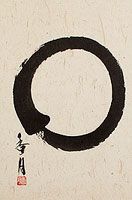
Here is the typical appearance of Enso artwork by Japanese calligrapher Kougetsu.
Enso is not a Japanese Kanji character. It falls more into the category of a symbol. There is some debate, but many consider Enso to be a religious symbol.
Some call this “The Circle of Enlightenment.” Others call it the “Infinity Circle.” If you actually took the meanings of the two Kanji (円相) that make up the word “En-so,” you could read it as “Mutual Circle” or “Circle of Togetherness.” I think the Enso symbol can simply mean different things to different people. Therefore, you should let it have the meaning that you perceive.
The appearance of your Enso will be determined by the artist's personal style, feeling, mood, etc.
Fire
(One of the five elements)
火 is the symbol for fire, flame, or blaze in Chinese, Korean and Japanese.
Fire is one of the five elements that ancient Chinese believed all things were composed of. These elements are also part of the cycle of Chinese astrology. Every person has both an animal sign, and one of the five elements according to the date of their birth. See also Five Elements and Chinese 12 Animals / Zodiac.
See Also: Five Elements
Water
(One of the five elements)
水 is the symbol for water in Chinese, Japanese Kanji, and old Korean Hanja.
Water is one of the five elements that ancient Chinese believed all things were composed of. These elements are also part of the cycle of Chinese astrology. Every person has both an animal sign, and one of the five elements according to the date of their birth. See also Five Elements and Chinese 12 Animals / Zodiac.
Repel Evil / Expel the Devil
驅魔 is the way you would write a sign or symbol to repel the devil or drive away evil in Chinese.
Ba Gua
Wisdom Lotus
Raven / Crow
鴉 is raven or crow in Chinese characters, old Korean Hanja, and Japanese Kanji. 鴉 is also an abbreviation for the Corvus species.
If this is your favorite bird, hang this symbol on your wall.
Note: Can also be the surname Karasu in Japanese.
Wood
(One of the five elements)
木 is the symbol for wood in Japanese, Korean and Chinese.
This can sometimes mean “tree” depending on context. In fact, the character comes from a pictogram that is supposed to resemble a tree.
Wood is one of the five elements that ancient Chinese believed all things were composed of. These elements are also part of the cycle of Chinese astrology. Every person has both an animal sign, and one of the five elements according to the date of their birth. See also Five Elements and Chinese 12 Animals / Zodiac.
Gold / Metal
(One of the five elements)
金 is the symbol for metal (often means gold or money) in Chinese, Korean and Japanese.
In an interesting twist, in Japanese, this Kanji can also mean “Friday.” I guess Friday is “the golden day” in Japan.
Gold / Metal is one of the five elements that ancient Chinese believed all things were composed of. These elements are also part of the cycle of Chinese astrology. Every person has both an animal sign, and one of the five elements according to the date of their birth. See also Five Elements and Chinese 12 Animals / Zodiac.
Crane
Graceful bird of longevity
鶴 is a famous bird of China.
Known in China to be a very spiritual creature, the crane is a symbol of both longevity and the journey of the souls and spirits of ancestors.
Note: 鶴 can mean crane or stork in Japanese.
Black Raven
烏 can mean raven or crow but is also used as an alternate way to write the color black.
Therefore, this is a symbol of the black raven (with emphasis on black). This can also mean rook or dark.
Notes: This can be the Japanese surname Karasu, or Chinese surname Wu.
Dragon Warrior
Thunder
雷 can mean thunder, lightning, thunderbolt, mine (weapon), or slang for something terrifying or a fit of anger.
Some will say it is the symbol of the god of thunder or the god of lightning.
雷 is also a Chinese surname that romanizes as Lei.
Rebel / Insurgent
People keep asking me for rebel as a single Chinese character, Korean Hanja, or Japanese Kanji.
The problem is, rebel is not really a good word in Asian culture (depending on the context in which it is used). 賊 is a rebel symbol that can also mean thief; traitor; evil; robber; burglar; insurgent; or a spoiler. Used as an adjective, it can mean wily or deceitful.
Happiness / Joyful / Joy
喜 is the Chinese, Japanese Kanji, and Korean Hanja for the kind of happiness known in the west as “joy.”
喜 can also be translated as rejoice, enjoyment, delighted, pleased, or “take pleasure in.” Sometimes it can mean “to be fond of” (in a certain context).
If you write two of these happiness/joy characters side by side, you create another character known in English as “double happiness,” which is a symbol associated with weddings and happy marriages.
There is another version of this character that you will find on our website with an additional radical on the left side (exactly same meaning, just an alternate form). The version of happiness shown here is the commonly written form in China, Japan and South Korea (banned in North Korea).
See Also: Contentment | Happiness | Joy
Heike Star / Betelgeuse
平家星 is the old Japanese title for the Betelgeuse star in the constellation Orion.
While also known as Alpha Orionis or Betelgeuse in the West, this was the “Heike star” in Japan.
The powerful Taira clan, known colloquially as the 平家 (Heike clan), adopted this star's red color as its symbol sometime in the late 800s AD. They called the star 平家星 (Heike-boshi).
Bamboo
竹 is the character that means bamboo in Chinese, Japanese Kanji, and old Korean Hanja.
In Asian cultures, bamboo is often seen as a symbol of a noble gentleman (tall, straight, and honest).
There are also some multi-character bamboo words that regard individual bamboo plants, species of bamboo, bamboo as lumber, and edible bamboo shoots. However, this single character seems most appropriate for a wall scroll and covers the whole category of Asian bamboo.
Peace / Harmony
和 is the simplest form of peace and harmony.
和 can also be translated as the peaceful ideas of gentle, mild, kind, and calm. With a more harmonious context, it can be translated as union, together with, on good terms with, or on friendly terms.
Most people would just translate this character as peace and/or harmony. 和 is a very popular character in Asian cultures - you can even call it the “peace symbol” of Asia. In fact, this peace and harmony character was seen repeatedly during the opening ceremony of the 2008 Olympic Games in Beijing (a major theme of the games).
In old Chinese poems and literature, you might see this used as a kind of "and." As in two things summed together. As much as you could say, "the sun and moon," you could say "the sun in harmony with the moon."
See Also: Inner Peace | Patience | Simplicity
Adamantine / King Kong
金剛 can translate as adamantine from Chinese, Japanese, and old Korean.
Other meanings and translations can include diamond, thunderbolt, Indra's indestructible weapon, a Buddhist symbol of the indestructible truth, Vajra (a mythical weapon), guardian deity, hardness, indestructibility, power, the least frangible of minerals.
The Chinese pronunciation of “Jīn Gāng” became the loanword used in English as “King Kong.” You can see King Kong as the indestructible ape guardian deity depending on how you read the story.
Yin Yang
陰陽 literally means yin and yang in written form (versus the common yin-yang symbol). The first character has the element of the moon, while the second character has the element of the sun so that you can see, even in written form, they suggest the balance of opposites (of night and day). You could also translate this title as “sun and moon.”
Note: This title is often misspelled as Ying Yang instead of Yin Yang.
See Also: Taoism
露 is the Chinese, Japanese Kanji, and old Korean Hanja for dew.
Depending on the context in which this character is used, it can also mean: tears; syrup; nectar; outdoors (not under cover); to show; to reveal; to betray; to expose; scanty; bare; unconcealed; naked; public.
露 can be a Chinese surname Lu. 露 can also be the Japanese surname Tsuyuzaki or Tsuyusaki, and the given names Tsuyu or Akira.
Oddly, 露 is sometimes used as an abbreviation for Russia.
In the Buddhist context, 露 also means dew, but can be a symbol of transience. Sometimes used as a metaphor to expose or disclose knowledge and truth.
Diamond
金剛 is a common way to call diamonds in Chinese and Japanese.
Traditionally, there were not that many diamonds that made their way to Asia, so this word does not have the deep cultural significance that it does in the west (thanks mostly to De Beers' marketing). Therefore, this word was kind of borrowed from other uses.
This title can also refer to vajra (a Sanskrit word meaning both thunderbolt and diamond that originally refers to an indestructible substance); hard metal; pupa of certain insects; Vajrapani, Buddha's warrior attendant; King Kong; adamantine; Buddhist symbol of the indestructible truth.
Good Luck / Good Fortune
福 is pronounced “fu” in Chinese.
The character “fu” is posted by virtually all Chinese people on the doors of their homes during the Spring Festival (closely associated with the Chinese New Year).
One tradition from the Zhou Dynasty (beginning in 256 B.C.) holds that putting a fu symbol on your front door will keep the goddess of poverty away.
福 literally means good fortune, prosperity, blessed, blessedness, happiness, and fulfillment.
You'll also see this character in Vietnam (where Chinese characters were the written form until a romanization reform) where it is pronounced Phúc - a word commonly used in Vietnamese names because of its good meaning.
See Also: Lucky
Sword
劍 is pronounced “jian” in Chinese. When you say it, imagine that you are making the sound of a sword as it clashes with a metal shield. This might get you closer to the correct pronunciation in Chinese.
I actually wonder if this word came from the metallic ringing sounds of a sword in battle - but such knowledge is lost in history.
The sword is a symbol of a warrior. The one thing that a soldier in ancient China lived and died by. A warrior with his skills and sword proves himself of great value. A warrior who losses his sword instantly becomes worthless.
劍 is an excellent scroll for someone in the military (especially officers of all services - as well as enlisted NCO Marines since they still carry swords even if mainly for ceremonial purposes). Or perhaps someone who practices variations of kung fu or tai chi that involve weapons.
Please note that while this character is understood with the sword meaning in Japanese, you might be looking for the word “katana” which also means sword in Japanese but means “knife” in Chinese.
There are other ways to write sword, and here are a few...
























![]()
![]()
![]()
![]()


If you are particular about the version you receive, please let me know when you place your order (Note: Special styles are only available from one of our master calligraphers).
Double Happiness
(Happy wedding and marriage)
囍 is a common gift for Chinese couples getting married or newly married couples.
As we say in the west, “Two heads are better than one” Well, in the east, two “happinesses” are certainly better than one.
Some will suggest this is a symbol of two happinesses coming together. Others see it as a multiplication of happiness because of the union or marriage.
囍 is not really a character that is pronounced very often - it's almost exclusively used in written form. However, if pressed, most Chinese people will pronounce this “shuang xi” (double happy) although literally there are two “xi” characters combined in this calligraphy (but nobody will say “xi xi”).
 If you select this character, I strongly suggest the festive bright red paper for your calligraphy. Part of my suggestion comes from the fact that red is a good luck color in China, and this will add to the sentiment that you wish to convey with this scroll to the happy couple.
If you select this character, I strongly suggest the festive bright red paper for your calligraphy. Part of my suggestion comes from the fact that red is a good luck color in China, and this will add to the sentiment that you wish to convey with this scroll to the happy couple.
Broken Mirror Rejoined
Used in modern times for divorced couples that come back together
破鏡重圓 is about a husband and wife who were separated and reunited.
About 1500 years ago in China, there lived a beautiful princess named Le Chang. She and her husband Xu De Yan loved each other very much. But when the army of the Sui Dynasty was about to attack their kingdom, disposed of all of their worldly possessions and prepared to flee into exile.
They knew that in the chaos, they might lose track of each other, so the one possession they kept was a bronze mirror which is a symbol of unity for a husband and wife. They broke the mirror into two pieces, and each of them kept half of the mirror. They decided that if separated, they would try to meet at the fair during the 15th day of the first lunar month (which is the lantern festival). Unfortunately, the occupation was brutal, and the princess was forced to become the mistress of the new commissioner of the territory, Yang Su.
At the Lantern Festival the next year, the husband came to the fair to search for his wife. He carried with him his half of the mirror. As he walked through the fair, he saw the other half of the mirror for sale at a junk market by a servant of the commissioner. The husband recognized his wife's half of the mirror immediately, and tears rolled down his face as he was told by the servant about the bitter and loveless life that the princess had endured.
As his tears dripped onto the mirror, the husband scratched a poem into his wife's half of the mirror:
You left me with the severed mirror,
The mirror has returned, but absent are you,
As I gaze in the mirror, I seek your face,
I see the moon, but as for you, I see not a trace.
The servant brought the inscribed half of the mirror back to the princess. For many days, the princess could not stop crying when she found that her husband was alive and still loved her.
Commissioner Yang Su, becoming aware of this saga, realized that he could never obtain the princess's love. He sent for the husband and allowed them to reunite.
This proverb, 破鏡重圓, is now used to describe a couple who has been torn apart for some reason (usually divorce) but have come back together (or remarried).
It seems to be more common these days in America for divorced couples to reconcile and get married to each other again. This will be a great gift if you know someone who is about to remarry their ex.
This in-stock artwork might be what you are looking for, and ships right away...
Gallery Price: $200.00
Your Price: $124.88
Gallery Price: $200.00
Your Price: $98.88
Gallery Price: $40.00
Your Price: $16.88
These search terms might be related to Symbol:
Aquarius Zodiac Symbol / Sign
Aries Zodiac Symbol / Sign
Cancer Zodiac Symbol / Sign
Capricorn Zodiac Symbol / Sign
Character
Conquering Yourself is a Sign of Strength
Discipline / Training / Tempering Character
Fortitude / Strength of Character
Gemini Zodiac Symbol / Sign
Leo Zodiac Symbol / Sign
Libra Zodiac Symbol / Sign
Man of Character
Man of Remarkable Character / Hero
Mark
Mark the Boat to Find the Lost Sword / Ignoring the Changing Circumstances of the World
Mark-Anthony
Ophiuchus Zodiac Symbol / Sign
Person of Character
Pisces Zodiac Symbol / Sign
Sagittarius Zodiac Symbol / Sign
Scorpio Zodiac Symbol / Sign
Taurus Zodiac Symbol / Sign
Virgo Zodiac Symbol / Sign
Woman of Strong Character / Woman Hero
The following table may be helpful for those studying Chinese or Japanese...
| Title | Characters | Romaji (Romanized Japanese) | Various forms of Romanized Chinese | |
| Reiki - Master Symbol | 大光明 | dai kou myou daikoumyou dai ko myo | dà guāng míng da4 guang1 ming2 da guang ming daguangming | ta kuang ming takuangming |
| Dragon Emperor Symbol | 竜 | ryuu / tatsu ryu / tatsu | lóng / long2 / long | lung |
| Cancer Zodiac Symbol Sign | 蟹座 | kani-za | xiè zuò / xie4 zuo4 / xie zuo / xiezuo | hsieh tso / hsiehtso |
| Pisces Zodiac Symbol Sign | 魚座 鱼座 | uo-za | yú zuò / yu2 zuo4 / yu zuo / yuzuo | yü tso / yütso |
| Scorpio Zodiac Symbol Sign | 蠍座 蝎座 | sasori-za | ||
| Aquarius Zodiac Symbol Sign | 水瓶座 | mizugame-za | shuǐ píng zuò shui3 ping2 zuo4 shui ping zuo shuipingzuo | shui p`ing tso shuipingtso shui ping tso |
| Aries Zodiac Symbol Sign | 牡羊座 | ohitsuji-za | mù yáng zuò mu4 yang2 zuo4 mu yang zuo muyangzuo | mu yang tso muyangtso |
| Aries Zodiac Symbol Sign | 白羊座 | bái yáng zuò bai2 yang2 zuo4 bai yang zuo baiyangzuo | pai yang tso paiyangtso |
|
| Cancer Zodiac Symbol Sign | 巨蟹座 | jù xiè zuò ju4 xie4 zuo4 ju xie zuo juxiezuo | chü hsieh tso chühsiehtso |
|
| Capricorn Zodiac Symbol Sign | 山羊座 | yagi-za | shān yáng zuò shan1 yang2 zuo4 shan yang zuo shanyangzuo | shan yang tso shanyangtso |
| Capricorn Zodiac Symbol Sign | 摩羯座 | mó jié zuò mo2 jie2 zuo4 mo jie zuo mojiezuo | mo chieh tso mochiehtso |
|
| Gemini Zodiac Symbol Sign | 雙子座 双子座 | futago-za | shuāng zǐ zuò shuang1 zi3 zuo4 shuang zi zuo shuangzizuo | shuang tzu tso shuangtzutso |
| Gemini Zodiac Symbol Sign | 雙子座 双子座 | futago-za | shuāng zǐ zuò shuang1 zi3 zuo4 shuang zi zuo shuangzizuo | shuang tzu tso shuangtzutso |
| Leo Zodiac Symbol Sign | 獅子座 狮子座 | shishi-za | shī zǐ zuò shi1 zi3 zuo4 shi zi zuo shizizuo | shih tzu tso shihtzutso |
| Libra Zodiac Symbol Sign | 天秤座 | tenbin-za | tiān chèng zuò tian1 cheng4 zuo4 tian cheng zuo tianchengzuo | t`ien ch`eng tso tienchengtso tien cheng tso |
| Ophiuchus Zodiac Symbol Sign | 蛇夫座 | shé fū zuò she2 fu1 zuo4 she fu zuo shefuzuo | she fu tso shefutso |
|
| Pisces Zodiac Symbol Sign | 雙魚座 双鱼座 | shuāng yú zuò shuang1 yu2 zuo4 shuang yu zuo shuangyuzuo | shuang yü tso shuangyütso |
|
| Sagittarius Zodiac Symbol Sign | 射手座 | ite-za | shè shǒu zuò she4 shou3 zuo4 she shou zuo sheshouzuo | she shou tso sheshoutso |
| Scorpio Zodiac Symbol Sign | 天蠍座 天蝎座 | tiān xiē zuò tian1 xie1 zuo4 tian xie zuo tianxiezuo | t`ien hsieh tso tienhsiehtso tien hsieh tso |
|
| Taurus Zodiac Symbol Sign | 金牛座 | jīn niú zuò jin1 niu2 zuo4 jin niu zuo jinniuzuo | chin niu tso chinniutso |
|
| Taurus Zodiac Symbol Sign | 牡牛座 | oushi-za / oshi-za | ||
| Virgo Zodiac Symbol Sign | 處女座 处女座 | chù nǚ zuò chu4 nv3 zuo4 chu nv zuo chunvzuo | ch`u nü tso chunütso chu nü tso |
|
| Virgo Zodiac Symbol Sign | 乙女座 | otome-za | yǐ nǚ zuò yi3 nv3 zuo4 yi nv zuo yinvzuo | i nü tso inütso |
| Enso - Japanese Zen Circle | 〇 | en sou / ensou / en so | ||
| Fire | 火 | hi | huǒ / huo3 / huo | |
| Water | 水 | mizu / sui | shuǐ / shui3 / shui | |
| Repel Evil Expel the Devil | 驅魔 驱魔 | qū mó / qu1 mo2 / qu mo / qumo | ch`ü mo / chümo / chü mo | |
| Ba Gua | 八卦 | bā guà / ba1 gua4 / ba gua / bagua | pa kua / pakua | |
| Wisdom Lotus | 妙蓮華 妙莲华 | myō renge / myōrenge | miào lián huá miao4 lian2 hua2 miao lian hua miaolianhua | miao lien hua miaolienhua |
| Raven Crow | 鴉 鸦 | karasu | yā / ya1 / ya | |
| Wood | 木 | ki | mù / mu4 / mu | |
| Gold Metal | 金 | kin | jīn / jin1 / jin | chin |
| Crane | 鶴 鹤 | gaku / tsuru | hè / he4 / he | ho |
| Black Raven | 烏 乌 | karasu | wū / wu1 / wu | |
| Dragon Warrior | 龍武士 龙武士 | ryuu bu shi ryuubushi ryu bu shi | lóng wǔ shì long2 wu3 shi4 long wu shi longwushi | lung wu shih lungwushih |
| Thunder | 雷 | rai / kaminari | léi / lei2 / lei | |
| Rebel Insurgent | 賊 贼 | zoku | zéi / zei2 / zei | tsei |
| Happiness Joyful Joy | 喜 | ki / yorokobi | xǐ / xi3 / xi | hsi |
| Heike Star Betelgeuse | 平家星 | hei ke boshi heikeboshi | ||
| Bamboo | 竹 | take | zhú / zhu2 / zhu | chu |
| Peace Harmony | 和 | wa | hé / he2 / he | ho |
| Adamantine King Kong | 金剛 金刚 | kongou / kongo | jīn gāng / jin1 gang1 / jin gang / jingang | chin kang / chinkang |
| Yin Yang | 陰陽 阴阳 | in you / inyou / in yo | yīn yáng / yin1 yang2 / yin yang / yinyang | |
| Dew | 露 | ro | lòu / lou4 / lou | |
| Diamond | 金剛 金刚 | kon gou / kongou / kon go | jīn gāng / jin1 gang1 / jin gang / jingang | chin kang / chinkang |
| Good Luck Good Fortune | 福 | fuku | fú / fu2 / fu | |
| Sword | 劍 剑 | ken / tsurugi | jiàn / jian4 / jian | chien |
| Double Happiness | 囍 喜喜 | xǐ / xi3 / xi | hsi | |
| Broken Mirror Rejoined | 破鏡重圓 破镜重圆 | pò jìng chóng yuán po4 jing4 chong2 yuan2 po jing chong yuan pojingchongyuan | p`o ching ch`ung yüan pochingchungyüan po ching chung yüan |
|
| In some entries above you will see that characters have different versions above and below a line. In these cases, the characters above the line are Traditional Chinese, while the ones below are Simplified Chinese. | ||||
Successful Chinese Character and Japanese Kanji calligraphy searches within the last few hours...

